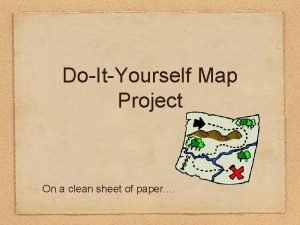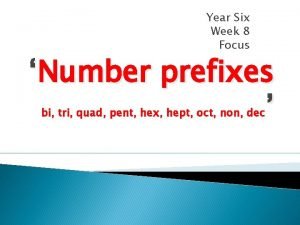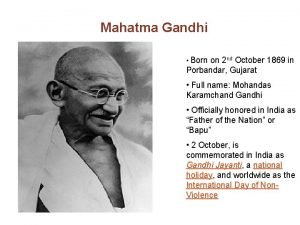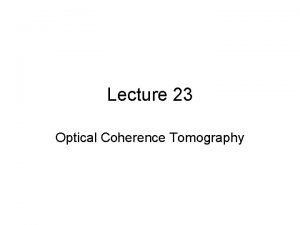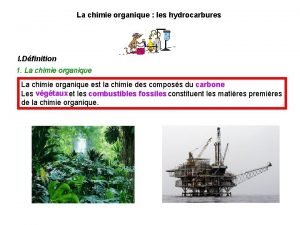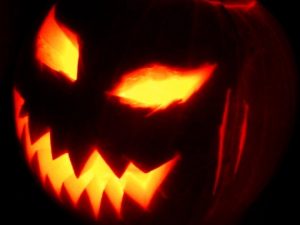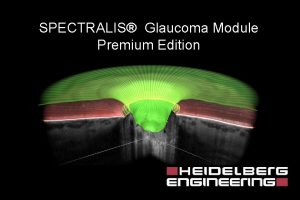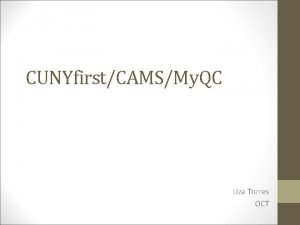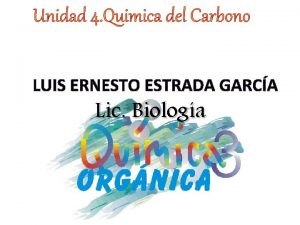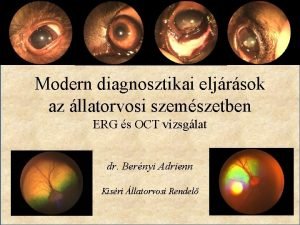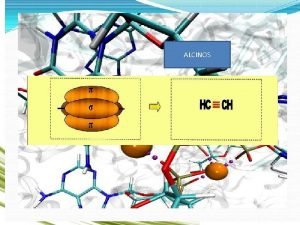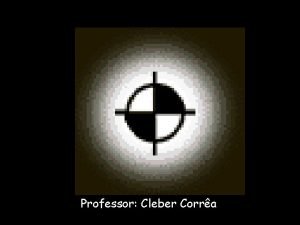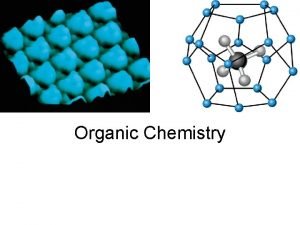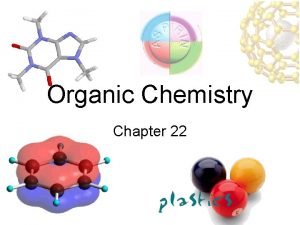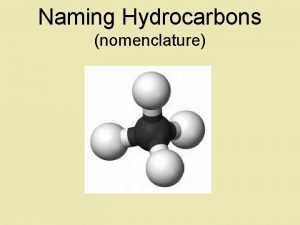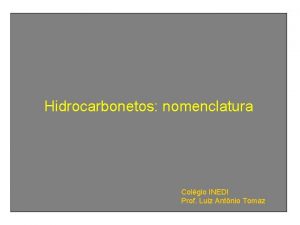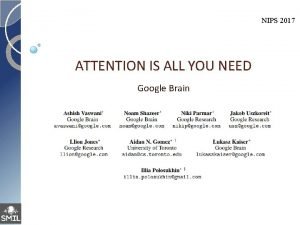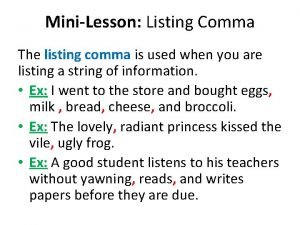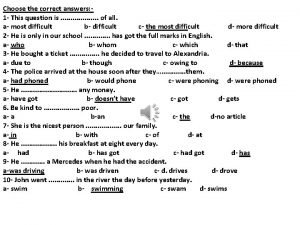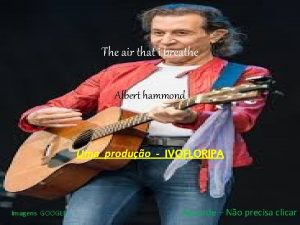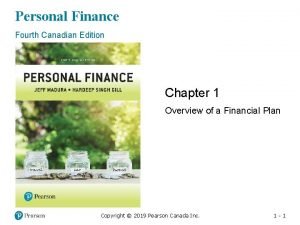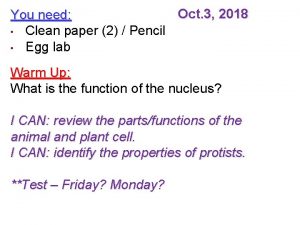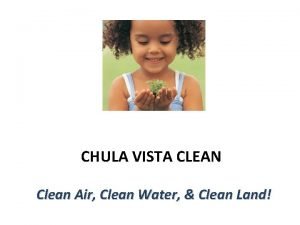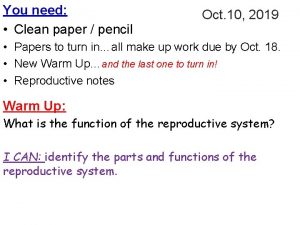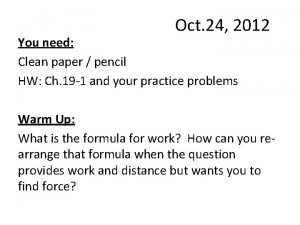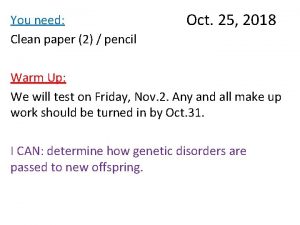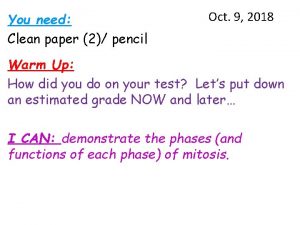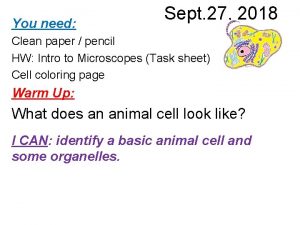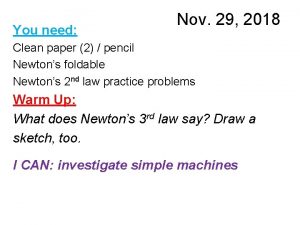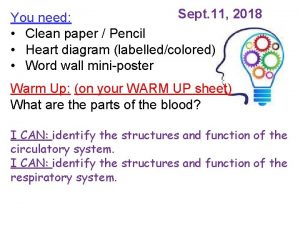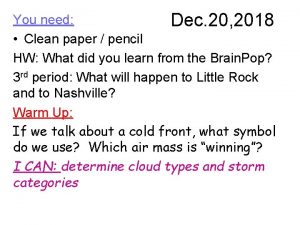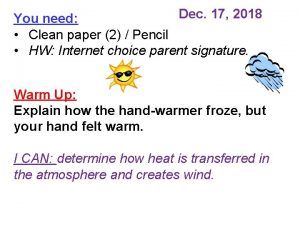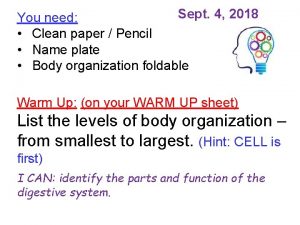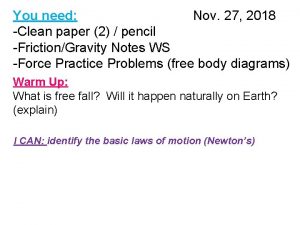You need Oct 22 2018 Clean paper 2








































































- Slides: 72

You need: Oct. 22, 2018 Clean paper (2)/ pencil Sponge. Bob genetics HW New Warm Up sheet Warm Up: Define genotype and phenotype. How are they alike? How are they different? I CAN: build a Punnett square and analyze the probability of offspring.

Chromosome Nucleus Cell Gene D A N

Vocabulary • Chromosomes – DNA wound into cute pkg • Genes – section of DNA/chromosome that codes for a specific trait • Traits – an organism’s physical features • Alleles – versions of a gene… – Dominant allele: the one that will always show – Recessive allele: the one that can be hidden

Vocabulary • HOMOzygous- two of the SAME alleles • HETEROzygous- two DIFFERENT alleles • Genotype – the genes or alleles inside (typically the letter combos) • Phenotype – the physical expression of those alleles (how they show up)


Mendel: Understanding Inheritance Gregor Mendel “The father of genetics” 1822 -1864

What is Genetics? • GENETICS - is the science of how traits are inherited. In other words, how traits pass from parent to offspring.

What are TRAITS? • TRAITS are characteristics (the way we look, are, or think). • For example, being tall or short, blond or dark-haired, brown eyes or blue eyes, light or dark skinned, funny or serious, etc… • Traits are genetic and are passed down from parent to offspring.

Who was Gregor Mendel? • Gregor Mendel was an Austrian monk, who lived in the 1800’s. • Mendel conducted thousands of experiments on pea plants to see how traits (shape, color) were passed from generation to generation. • Mendel is known as the “Father of Genetics” for figuring out the basic rules of how traits are inherited.

What type of experiments did Mendel do? • Mendel crossed pea plants with different traits (eg. tall & short). • He started with PUREBRED plants (showed same trait for many generations – short parents had short offspring) • He crossed a tall parent with a short parent to see what the offspring plants would look like.

What happened? The 1 st generation of offspring were ALL tall! The short trait was “lost” – it had disappeared. In the 2 nd generation, the “lost” short trait reappeared in ¼ of the offspring. (Even though neither parent was short!)

• Mendel tested MANY traits – and found that one form of the trait was always “dominant” in the first generation of offspring, but that the “hidden” trait re-appeared in 25% of the second generation.

Mendel’s rules of inheritance? • Mendel figured out that: • Traits are controlled by PAIRS of “factors” (genes) that are inherited from your parents (one from mom, one from dad). • Some factors are “dominant” - they mask or hide the other factor. • (For example, the tallness gene hides the shortness gene in pea plants. )

Let’s get the new vocabulary straight… • GENES - are the factors that control an inherited trait. • ALLELES – are the different forms of a gene. • (the TALL and SHORT alleles are the 2 forms of the HEIGHT gene in pea plants) • *We inherit one allele (or form of a gene) from our mom and one allele from our dad, so we have 2 alleles for every gene.

Let’s get the new vocabulary straight… • DOMINANT ALLELE - is one whose trait always shows up when the allele is present. • It can mask or hide the other form of the trait. • It is shown with an upper-case letter, for example “T”. • Example: Tall stems = TT or Tt

Let’s get the new vocabulary straight… • RECESSIVE ALLELE – is one whose trait is hidden whenever the dominant allele is present. • It will only show up if BOTH alleles are recessive. • It is shown with a lower-case letter, for example “t”. • Example: Short stems = tt

Let’s get the new vocabulary straight… • HOMOZYGOUS Organisms with 2 same alleles. TT • HETEROZYGOUS Tt Organisms with 2 different alleles. tt Tt

SUMMARY • When studying genetics, we need to take 2 things into account: Ø PHENOTYPE - an organism’s PHYSICAL appearance. (3 plants are tall, 1 is short) Ø GENOTYPE – an organism’s GENETIC makeup (alleles). (1 plant is TT, 2 plants are Tt, and 1 plant is tt) TT Tt Tt tt

Probability & Heredity: Punnett Squares

How can we figure out which traits will be inherited? • We’ve learned about dominant & recessive alleles: • Dominant alleles are more powerful, and can “hide” a recessive trait. – Shown with an upper-case letter (“T” for tall stems) • Recessive alleles can be “hidden” when a dominant allele is present. – Shown with a lower-case letter (“t” for short stems)

How can we figure out which traits will be inherited? • You know the differences between genotype and phenotype: • Genotype describes which genes (alleles) are present. » TT = 2 dominant alleles » Tt = 1 dominant & 1 recessive » tt = 2 recessive alleles • Phenotype describes what the physical trait looks like. » Tall stems (TT and Tt) » Short stems (tt)

More vocabulary… • Geneticist use 2 terms to describe GENOTYPE: • Homozygous – the organism has 2 same alleles. » TT = 2 dominant alleles » tt = 2 recessive alleles • Heterozygous – the organism has 2 different alleles. » Tt = 1 dominant & 1 recessive allele

So, how do we know which genotype or phenotype the offspring will be? • We can use a tool called a punnett square to predict how likely it is for an offspring to inherit certain traits. • A PUNNETT SQUARE: • is a chart that shows ALL the possible combinations of a genetic cross. • shows genotype and phenotype of the offspring. • is also used to predict the probability (the chance) that an offspring will have a certain trait.


How do we draw a Punnett Square?

• “R” is dominant for Round seeds. • “r” is recessive for wrinkled seeds. • Both parents are “heterozygous” and have round seeds.




• The two-letter combinations are the possible genotypes of the offspring. • They are RR, Rr, and rr genotypes. • From this it is possible to determine the “probability” (chance) that a seed will have: – a round seed phenotype (3/4 or 75%) OR – a wrinkled seed phenotype (1/4 or 25%)

Try one on your own… • Cross a homozygous guinea pig with black fur (BB) with a homozygous guinea pig with white fur (bb). • (Black fur is dominant over white fur).

Try one on your own… • Cross a homozygous guinea pig with black fur (BB) with a homozygous guinea pig with white fur (bb). B b b B

Try one on your own… • Cross a homozygous guinea pig with black fur (BB) with a homozygous guinea pig with white fur (bb). B b b B

Try one on your own… • Cross a homozygous guinea pig with black fur (BB) with a homozygous guinea pig with white fur (bb). B B bb B B

The result? • All 4 possible offspring will be heterozygous and have one dominant allele for black fur and 1 recessive allele for white fur. All the guinea pigs will have the black fur phenotype; and Bb genotype.

More practice problems… 1) Cross a heterozygous tall pea plant (Tt) with a homozygous short pea plant (tt). Tall stems (T) are dominant over short stems (t). What are the possible offspring from this cross? 2) Cross a rabbit who is heterozygous for short ears (Ee) with another rabbit who is heterozygous for short ears (Ee). Short ears (E) are dominant over long, floppy ears (e). What are the possible offspring from this cross?

MO M Tt Mom = _____ tt Dad = _____ T _______ is t dominant _______ is recessive ______ % is homozygous dominant ______ % is homozygous recessive ______ % is heterozygous DAD

MO M E Mom = _____ Ee Dad = _____ e E -_______ is short edominant _______ is long recessive ______ % is homozygous dominant ______ % is homozygous recessive ______ % is heterozygous DAD

More practice problems… Bikini Bottom Genetics!

Homo Hetero Homo Homo Alll Homozygous All Heterozygous

YELLOW SQUARE blue round

TT , Tt PP , Pp tt pp

Bob = Ss Susie = ss

S s s S e i s u s s s Round Heterozygous Homozygous recessive S s Square Homozygous Heterozygous recessive s Square S ss Round b Bo

Genotypes: Ss, ss Phenotypes: Square, round Square shape = 2/4 or 50% Round shape = 2/4 or 50%

Quick Quiz: Based on your homework, write #6 onto your clean notebook paper. You do NOT have to write the complete question. • Draw out the Punnett square. • Label the Punnett square and fill in the information. • Give the letter combos (genotype) AND the word for genotype. • Give the word form of each phenotype. • Give the answers to the questions included (be sure to use %)




Omah and Opah

Omah and Opah Omah 392 Earth years old Opah 389 Earth years old

Omah and Opah Omah 392 Earth years old Opah 389 Earth years old

1. Large, branched 2. Short, not branched 3. Medium, not branched

1. Large, branched 2. Short, not branched 3. Medium, not branched Since there are THREE ways for this to show, but only two genes…is one truly dominant over the other? NO – they must mix or blend. We call this ________ INCOMPLETE DOMINANCE

A B B – large, branched S – short, not branched AS 1. Large, branched 2. Short, not branched 3. Medium, not branched AA B B A AS B AS AS A B AS

Omah and Opah Omah 392 Earth years old AB A BA S Opah 389 Earth years old AS A S

Omah and Opah Omah 392 Earth years old Opah 389 Earth years old


Omah and Opah Omah 392 Earth years old Opah 389 Earth years old

M m Large Small Big mouth M Small mouth m MM Mm mm ONLY two possibilities = so one is DOMINANT and the other is RECESSIVE!


Omah and Opah Omah 392 Earth years old Opah 389 Earth years old

Possible phenotypes… With Omah and Opah, they all look alike. But what about these?

Pointed P rounded p P and p Pointed rounded PP pp Pp

Narrow HN HW Narrow Wide INCOMPLETE DOMINANCE = blending

Omah and Opah Omah 392 Earth years old Opah 389 Earth years old


Omah and Opah Omah 392 Earth years old Opah 389 Earth years old


Omah and Opah Omah 392 Earth years old Opah 389 Earth years old


Review and vocabulary Pedigree Parent Filial / offspring Generations Traits Chromosomes Dominant (gene) Recessive (gene) We will add more as we go.
 Clean up everybody let's clean up
Clean up everybody let's clean up Que letra continua m v t m j
Que letra continua m v t m j Astroturf lobbying
Astroturf lobbying Copy the diversity card on a clean sheet of paper
Copy the diversity card on a clean sheet of paper On a clean sheet of paper draw yourself
On a clean sheet of paper draw yourself I wish you all the strength
I wish you all the strength Rules for speech punctuation
Rules for speech punctuation Key stage 1 reasoning paper 2018
Key stage 1 reasoning paper 2018 Bi tri quad
Bi tri quad October 2, 1869
October 2, 1869 Systemy liczbowe
Systemy liczbowe October 3rd 1993
October 3rd 1993 Low na
Low na Proppent
Proppent Sunset on october 31st
Sunset on october 31st Premium sanitas
Premium sanitas Visante oct
Visante oct Cunyfirst qc
Cunyfirst qc 15 carbonos
15 carbonos Stil testi
Stil testi Crash course chemistry naming compounds
Crash course chemistry naming compounds What is chemistry
What is chemistry Oct vizsgálat
Oct vizsgálat Met et prop but pent hex hept oct
Met et prop but pent hex hept oct Jhlt. 2019 oct; 38(10): 1015-1066
Jhlt. 2019 oct; 38(10): 1015-1066 Jhlt. 2019 oct; 38(10): 1015-1066
Jhlt. 2019 oct; 38(10): 1015-1066 Jhlt. 2019 oct; 38(10): 1015-1066
Jhlt. 2019 oct; 38(10): 1015-1066 Metil acetileno
Metil acetileno Propil
Propil Prop but pent hex hept oct
Prop but pent hex hept oct How are organic compounds classified
How are organic compounds classified Saturated bond
Saturated bond Hydrocarbons contain only _____.
Hydrocarbons contain only _____. Prop but pent hex hept oct
Prop but pent hex hept oct Met et prop but pent hex hept oct non dec
Met et prop but pent hex hept oct non dec Characteristics of homologous series
Characteristics of homologous series Hidrocarbonetos ramificados
Hidrocarbonetos ramificados Jhlt. 2019 oct; 38(10): 1015-1066
Jhlt. 2019 oct; 38(10): 1015-1066 Scleral lens oct
Scleral lens oct How do we keep our city clean
How do we keep our city clean I've told you to clean your room a million times
I've told you to clean your room a million times Would you mind ____ the window
Would you mind ____ the window Please clean the room before you live
Please clean the room before you live Please clean the room before you live
Please clean the room before you live Yes clean your room
Yes clean your room Aice english paper 2
Aice english paper 2 Aice general paper 1 exam
Aice general paper 1 exam It can be quite busy here during the tourist
It can be quite busy here during the tourist 5 hobbies you need
5 hobbies you need You only need to be lucky once
You only need to be lucky once Nips attention is all you need
Nips attention is all you need Example of why oxford comma is important
Example of why oxford comma is important Love is not all it is not meat nor drink
Love is not all it is not meat nor drink How many sentences do you need in a introduction
How many sentences do you need in a introduction Fsa essay format
Fsa essay format How do you sign your new passport
How do you sign your new passport What genre is an argumentative essay
What genre is an argumentative essay Everything you need to know about the odyssey
Everything you need to know about the odyssey High and low friction
High and low friction Velocitation means
Velocitation means Choose the correct answer questions
Choose the correct answer questions To have a friend you must be a friend
To have a friend you must be a friend You need to make at least 150 sandwiches for a picnic
You need to make at least 150 sandwiches for a picnic Much do you need health
Much do you need health You have need of endurance
You have need of endurance Lord i come i confess bowing here
Lord i come i confess bowing here All i need is the air that i breathe and to love you abba
All i need is the air that i breathe and to love you abba Mini questions
Mini questions Money is all you need
Money is all you need Lindell cooley i need you more
Lindell cooley i need you more Rain
Rain Eat meals that are nutritious agree or disagree
Eat meals that are nutritious agree or disagree If you think you can you can poem
If you think you can you can poem




